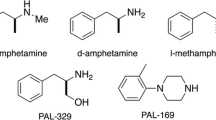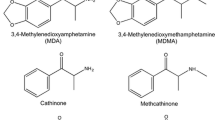Abstract.
Rationale: The neuronal actions of methamphetamine (MA) include an increase in extracellular levels of monoamines, presumably via reverse transport involving the monoamine transporters. This action is thought to play an important role in the effects of MA. Therefore, in the present experiment, it was hypothesized that a monoamine uptake blocker would block behavioral effects of MA related to its abuse. Objective: RTI 111, a newly synthesized 3-phenyltropane analog with high affinity for the dopamine, norepinephrine, and serotonin transporters, was evaluated alone and in combination with MA for its ability to block the reinforcing and discriminative stimulus effects of MA in rhesus monkeys. Methods: RTI 111 (0.0003–0.03 mg/kg, i.v.) was made available to four rhesus monkeys for self-administration under a fixed-ratio 25 (FR 25) schedule of reinforcement. RTI 111 (0.01–0.1 mg/kg, i.m.) was also administered as a pretreatment (15 min prior) to four monkeys self-administering MA (0.0–0.3 mg/kg per injection, i.v.) on a progressive-ratio schedule of reinforcement. MA (0.01–1.0 mg/kg, i.m.), RTI 111 (0.001–0.1 mg/kg, i.m.), or the combination of MA and RTI 111 were administered to four monkeys trained to discriminate (+)-amphetamine (AMPH; 1.0 or 1.7 mg/kg, intragastric) from saline. Results: When RTI 111 was made available for self-administration under an FR 25 schedule it functioned as a positive reinforcer in all four monkeys tested. When RTI 111 was given as a pretreatment to monkeys self-administering MA under a progressive-ratio schedule, the MA dose-response function shifted to the left and down. When RTI 111 or MA were given to monkeys trained to discriminate AMPH from saline, full AMPH-like responding was observed for both drugs. Given in combination, RTI 111 shifted the MA dose-response function to the left. Conclusions: These data suggest that RTI 111 is behaviorally similar to traditional psychomotor stimulants that act at the DA transporter and that it increases, rather than blocks, the behavioral potency of MA.
Similar content being viewed by others
Author information
Authors and Affiliations
Additional information
Electronic Publication
Rights and permissions
About this article
Cite this article
Ranaldi, R., Anderson, K., Ivy Carroll, F. et al. Reinforcing and discriminative stimulus effects of RTI 111, a 3-phenyltropane analog, in rhesus monkeys: interaction with methamphetamine. Psychopharmacology 153, 103–110 (2000). https://doi.org/10.1007/s002130000602
Received:
Accepted:
Issue Date:
DOI: https://doi.org/10.1007/s002130000602




